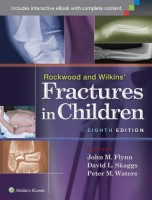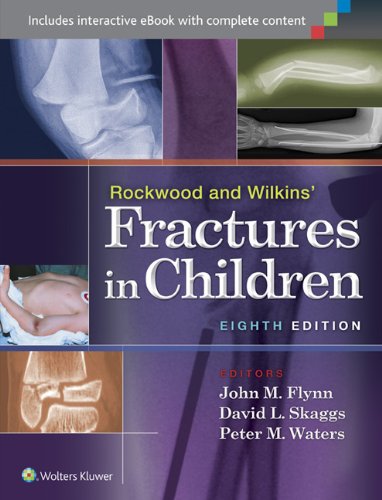 Editors: John M. Flynn, MD, David L. Skaggs, MD and Peter M. Waters, MD
Editors: John M. Flynn, MD, David L. Skaggs, MD and Peter M. Waters, MD
Publisher: Wolters Kluwer | Lippincott, Williams & Wilkins – 1,288 pages
Book Review by: Nano Khilnani
There are 206 bones in the human body, of which 106, or about half, are small bones in the hands and feet. The other (mostly) small bones are in the cranium, ankle, ear, face, feet, fingers, palms, throat, thorax, toes, vertebral column, and wrist, which total 84. The large bones are mainly in the shoulder, arms, pelvis, and legs, which total 16.
The main focus of this book is on the “repair” or “replacement” of these large bones – or orthopedic surgery – in children. This may seem to some an oversimplification of what this book is about, but it provides some a beginning perspective. An overview of the subjects contained in it is given below.
Fifty-nine physicians and surgeons from all over the United States (plus Canada and New Zealand) authored the 33 chapters of this book organized in four sections, which cover basic principles of orthopedic surgery, various types of fractures, and related subjects, as outlined in the book’s Content page:
- Basic Principles
- Epidemiology of Fractures in Children
- The Immature Skeleton
- Pain Management and Procedural Sedation for the Injured Child
- Cast and Splint Immobilization, Remodeling and Special Issues of Children’s Fractures
- Management of the Multiple-Injured Child
- Compartment Syndrome in Children
- Physeal Injuries and Growth Disturbances
- Pathologic Fractures
- The Orthopedic Recognition of Child Maltreatment
- Upper Extremity
- Fractures and Dislocations of the Head and Carpal Bones in Children
- Fractures of the Distal Radius and Ulna
- Diaphyseal Radius and Ulna Fractures
- Radial Neck and Olecranon Fractures
- Monteggia Fracture-Dislocation in Children
- Evaluation of Pediatric Distal
- Supracondylar Fractures of the Distal Humerus
- T-Condylar Distal Humerus Fractures
- Dislocation of the Elbows, Medial Epicondylar Humerus Fractures
- Lateral Condylar and Capitellar Fractures of the Distal Humerus
- Distal Humeral Phyeal. Medial Condyle, Lateral Epincondylar, and Other Uncommon Elbow Fractures
- Humeral Shaft and Proximal Humerus, Shoulder Dislocation
- Clavicle and Scapula Fractures: Acromioclavicular and Sternoclavicular Injuries
- Spine
- Cervical Spine Injuries in Children
- Thoracolumbar Spine Fractures
- Lower Extremity
- Pelvis and Acetabular Fractures
- Fractures and Traumatic Dislocations of the Hip in Children
- Femoral Shaft Fractures
- Fractures of the Distal Femoral Physis
- Proximal Tibial Physeal Fractures
- Intra-Articular Injuries of the Knee
- Fractures of the Shaft of the Tibia and Fibula
- Ankle Fractures
- Fractures and Dislocations of the Foot
As a purchaser of this book, you can enjoy its bundled interactive eBook edition as well, offering tablet, smart phone and online access to:
- Complete content with enhanced navigation
- A powerful search that pulls results from content in the book, your notes, even the web
- Cross-linked pages, references, and more for easy navigation
- Highlighting tool for easier reference of key content throughout the text
- Ability to take and share notes with friends and colleagues
- Quick reference tabbing to save your favorite content for future use
Here’s how to get started with your copy:
- Go to http://solution.lww.com/access
- Enter the Access Code found by scratching off the tab on inside front cover of your book
- Enter your information, click Submit, and follow on-screen instructions to start reading your eBook.
The book’s chapters give you first of all at the top of the chapter, an outline of what is covered in it, which typically but not all the time provides an Introduction, a Conclusion, and References. In between these three items you will find various topics and subtopics relating to the chapter’s title. Also provided to you are instructive black-and-white and color charts, drawings, figures, photos, radiographs, tables, and x-rays which illustrate the materials under study.
Interspersed within all these are helpful sections entitled Author’s Preferred Treatment. These provide you step-by-step instructions or the how-to on a given task. For example in chapter 3, Pain Management and Procedural Sedation for the Injured Child, Drs. Lois K. Lee and Travis H. Matheney write the basic steps involved in the blockade of the median, radial, musculocutaneous, and ulnar nerves at the elbow, with the help of a full-color line drawing and several photos of the elbow of a patient.
In the same chapter, guidelines with names of medication, formulation, and dose are provided in Table 3-11 entitled Dosing Formulations and Schedules for Oral Analgesic Medications for Children and Adolescents. The medications covered from top to bottom are: Acetaminophen, Hydrocodone with Acetaminophen, Hyrdomorphone, Ibuprofen, Morphine, Naproxen, Oxycodone, and Oxycodone + Acetaminophen. Across each medication, details as to Formulation and Dose are provided in this table. .
The benefits of having this book are numerous, but the main ones are that it provides you:
- New expanded coverage of pain medicine and casting
- Six NEW authors share their global perspective
- Thirteen full-length procedural videos
- NEW time-saving outline template for faster reference
- Step-by-step instructions and expert guidance on numerous operative and management techniques
- Author’s Preferred Treatment sections include algorithms explaining why the author chose that procedure
- Pearls and Pitfalls and preventive measures
The editors named below have expertly compiled, organized and presented the well-written materials of all the authors, who are recognized experts on the particular subjects of their respective chapters. In addition, the editors have also authored and coauthored some of the chapters.
John M. (Jack) Flynn, MD is Associate Professor of Orthopedic Surgery at the University of Pennsylvania School of Medicine; and Associate Chief of Orthopedic Surgery at the Children’s Hospital of Philadelphia in Philadelphia, Pennsylvania.
David L. Skaggs, MD is Chief of Orthopedic Surgery at Children’s Hospital Los Angeles; and Professor of Orthopedic Surgery at the University of Southern California School of Medicine in Los Angeles, California.
Peter M. Waters, MD is Clinical Chief of Orthopedic Surgery at Boston Children’s Hospital; Professor of Orthopedic Surgery, and John E. Hall Professor of Orthopedic Surgery at Harvard Medical School in Boston, Massachusetts.







